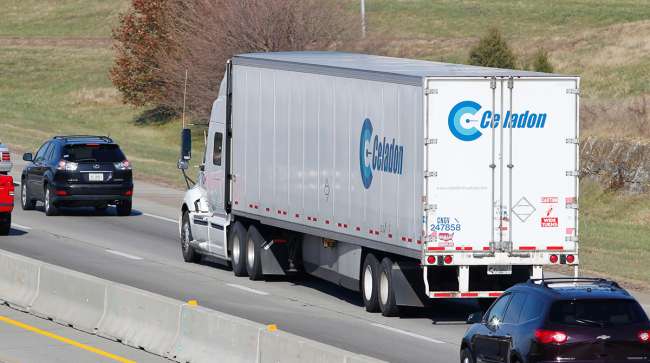Senior Reporter
Federal Judge Approves First Stage of Celadon Bankruptcy Plan

[Stay on top of transportation news: Get TTNews in your inbox.]
Celadon Group on Dec. 10 appeared in a federal bankruptcy court in Wilmington, Del., the day after it announced plans to file for Chapter 11 bankruptcy and wind down its operations under the weight of huge debt obligations and a weakening trucking market.
These challenges, analysts said, were simply too much for the company to overcome, despite efforts from current management to stage a turnaround.
Federal Bankruptcy Judge Karen Owens authorized Celadon to spend $5.4 million from an $8.2 million loan to pay employees and independent contractors and to close its Indianapolis-based trucking operation. A court-approved plan crafted by the company gives Celadon until the end of January to secure final approvals for sales of its assets.
The decision to declare bankruptcy comes just four months after 34-year-old Celadon secured $165 million through the sale of a 49.9% stake in the company to Luminus Management, a group that had previously owned about 17% of the company.
Despite this infusion, the timing was not conducive to a successful turnaround, said Jeffrey Kaufmann, an analyst with Loop Capital.
“I’m disappointed because they didn’t get the time that we thought they would have to get this fixed and turned around,” he told Transport Topics. “I think the markets in trucking were a lot tougher than many companies expected this fall and, unfortunately, that ended up being what caused the investors to pull the plug.” Celadon in its bankruptcy petition listed assets of $427 million and debt of $391 million.

More on Celadon
Dec. 16: Bankruptcy Judge OKs Plan to Keep Taylor Express Operating
Dec. 10: Analyst: Celadon ‘Didn’t Get the Time’ It Needed
Dec. 9: Celadon Files for Bankruptcy, Shuts Down
Dec. 5: Two Former Celadon Executives Charged in Fraud Scheme
Aug. 15: Celadon Gets $165 Million Infusion From Luminus Management
April 29: Celadon Group Sells Intermodal Operations to Bison Transport
April 25: Celadon to Pay $42.2 Million After Admitting to Accounting Fraud
April 22: Celadon Sells Logistics Group, Hopes for Financial Reporting in Fall
Oct. 3, 2017: Celadon Acknowledges Active SEC Investigation
July 13, 2017: Celadon Chairman, CEO Paul Will Steps Down
July 3, 2017: Celadon to Record Impairment Charge in Review of Company’s Value
May 2, 2017: Celadon's Financial Statements Called Into Question
April 25, 2016: Celadon Founder Russell Passes Away
June 23, 2014: Celadon’s Russell Used Hard Work, Luck To Build Large Cross-Border TL Carrier
“We have diligently explored all possible options to restructure Celadon and keep business operations ongoing, however, a number of legacy and market headwinds made this impossible to achieve,” Celadon CEO Paul Svindland said in a Dec. 9 statement.
Among those legacy headwinds was a $42.2 million fine levied against the company by the U.S. Department of Justice in the wake of an investigation of accounting fraud levied against prior management.
On Dec. 5, two former Celadon executives were indicted by the Securities and Exchange Commission on charges related to those allegations.
“The ability to fix the company probably became an impossible task when the DOJ filed the first complaints, back in June of 2018,” Donald Broughton, principal of Broughton Capital, told TT. In particular, he noted that Celadon’s legal issues made it harder to purchase new equipment and stay in business. “It severely inhibited their ability to renegotiate with creditors,” he said.
The New York Stock Exchange delisted Celadon in the spring of 2017 after it failed to submit quarterly and annual reports, as required by SEC. Before the bankruptcy, Celadon’s new leadership was planning to file financial statements dating back to February 2017 and amend those as far back as June 30, 2014. Kaufmann also noted that the company’s lack of published financial reports cost it business and hampered its recovery. “They didn’t have financial statements those customers could use to evaluate the risk of giving the company more business,” he said.
During the bankruptcy, Celadon is continuing to operate its Taylor Express division, which it intends to sell. That company is headquartered in Hope Mills, N.C., and delivers freight for Lowe’s and other businesses.
However, it is shutting down its Canadian subsidiary, Hyndman Transport, ending 82 years of operation. “The township extends our heartfelt thoughts and support to the displaced employees and their families that work for Hyndman Transport,” said Mayor Sue Foxton of North Dumfries, Ontario, where Hyndman was headquartered.
For one of Celadon’s U.S. drivers, the bankruptcy news arrived via a Dec. 8 phone call from a recruiter at another trucking company — a day ahead of Celadon’s official announcement. “They got my number from somebody at Celadon, and they were offering me a job because they heard the company was going under,” said Scott Riley, a 32-year industry veteran who six months ago rejoined Celadon due to the company’s attractive health care package. He’d previously driven for the carrier 25 years ago.
Riley said he is optimistic that Celadon will provide back pay to him and other drivers as the bankruptcy moves forward. Meantime, he’s happy to have found a new employer.
“When it came down to it, the trucking industry had each other’s back,” Riley said. “It was a great thing.”
Randy Mullett of Mullett Strategies in Washington, is optimistic Celadon’s drivers and those with other companies who were laid off will be back at work quickly.
“Celadon had 3,000 drivers. And how many million drivers are out there? This is a rounding error. It sounds big. But in the grand scheme of things, these drivers should be pretty easily absorbed if they’re decent drivers,” Mullett said. “Every motor carrier I know of, while some are trying to shed capacity, they generally have not stopped hiring, and they continue to look. If you’re a good driver, you have a good future."
According to the Federal Motor Carrier Safety Administration, as of October, Celadon was operating 2,771 trucks and had 2,553 drivers. It had a total of about 5,500 employees.
The company’s next bankruptcy court hearing is scheduled for Jan. 3.
Celadon ranks No. 38 on the Transport Topics Top 100 List of the largest for-hire companies in North America.
Want more news? Listen to today's daily briefing:

